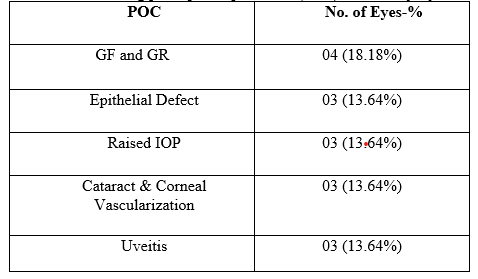Surgical outcome of optical penetrating keratoplasty in a rural tertiary care hospital
Abstract
Introduction: Optical Penetrating Keratoplasty (OPKP) is the gold standard surgical treatment for full-thickness corneal lesions and it is a well-established effective and safe technique. We conducted this study to verify the surgical outcome of OPKP at our rural hospital.
Aims and Objectives: To study the surgical outcome of OPKP in relation to corneal graft Clarity, Best Corrected Visual Acuity (BCVA), and Post-Operative Complications (POC)
Material and Methodology: In this prospective longitudinal hospital-based study we obtained postoperative data from patient’s records operated for OPKP from August 2018 to October 2019 after taking permission from IEC and patient’s consent. We included 22 patients who completed a minimum one-year follow-up.
Results: Out of 22 OPKPs, 50.00% were males. 18.18% of patients were in the 41-50 yrs age group. 1) Graft clarity was seen in 59.09%. 2) BCVA > 6/18was observed in 9.09% pts. 3) POC – Graft failure was seen in 18.18%. Epithelial defect, Raised IOP, Uveitis, Cataract and Corneal vascularization were other problems.
Conclusion: Though graft failure is a major complication, OPKP gives good BCVA and faster visual rehabilitation.
Downloads
References
Kanski J.J. , Clinical Ophthalmology , 6th edition, p-337-43, Butterworth 1989
Krachmer JH, Mannis MJ, Holland EJ. Cornea: Fundamentals, Diagnosis, and Management: Mosby Elsevier; 2011
John N, Jose R, Vashist P, Murthy GV. National Program for control of blindness, Rapid Assessment of Avoidable Blindness in India Report 2006-2007.
Menezes de Freitas, et al. causes and risk factors for graft failure in surgeries performed by physicians in Fellowship training. Cornea. 25 (3): 251-256, April 2006
Dandona L, Naduvilah TJ, Janarthanan M, Raghu K, Rao, Gullapalli N, et al. Survival analysis and visual outcome in a large series of corneal transplants in India. Br J Ophthalmol
Shanbhag N, Cholera PP, Sahana N, Chen L, Sujatha TS. Evaluation of Graft Clarity Post-Penetrating Keratoplasty.
Outcome of optical penetrating keratoplasties at a tertiary care eye institute in Western India Shilpa A Joshi, Seema S Jagdale, Pranav D More, Madan Deshpande. Indian J Ophthalmol 1996;44:3-13.
Surgical outcomes of penetrating Keratoplasty in adults at rural hospitals. Nigwekar S. et al., Med. Res. Chronicles.,6(3),136 – 145
Williams KA, Lowe M, Bartlett C, Kelly TL, Coster DJ. Risk factors for human corneal graft failure within the Australian corneal graft registry. Transplantation 2008;86:1720-4
Coster DJ, Williams KA. The impact of corneal allograft rejection on the long-term outcome of corneal transplantation. Am J Ophthalmol 2005;140:1112-22



























